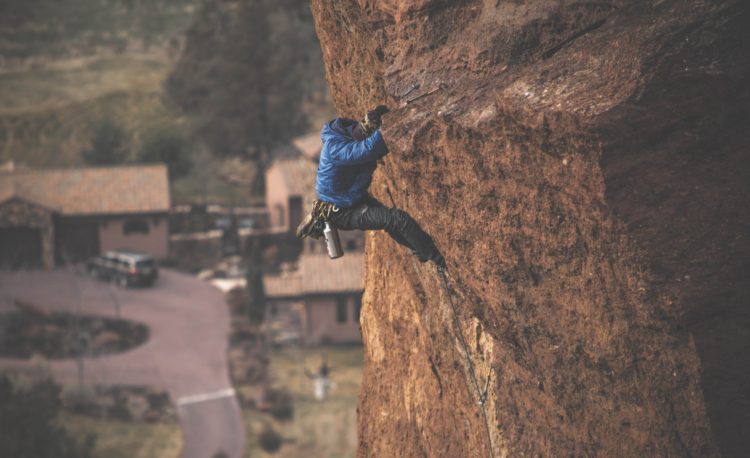The climbing community is a pretty cool group of people. We come from all backgrounds and we come in harmony together for the love of the climb. When you have a group of climbers together, you’ll find mostly men and some women. And a variance of height between all of them.
Inevitably, it begs the question, is there a height advantage or even disadvantage in rock climbing? Does it matter how tall you are for rock climbing? Who has the advantage, taller climbers or shorter climbers?
If you’ve been curious about trying out rock climbing and wondering if your too tall for it, then keep reading to find out what your height means for rock climbing.
Are you too tall for rock climbing?
The thing with climbing is that there are no right or wrong answers. Each person will face a different scenario when they face the rock, especially if they’re a different size. So does size really matter when you’re rock climbing? Is there such a thing as “too tall” in the climbing world?
The short answer to this is no, you’re not too tall. Even if you’re basketball-player-freakishly-tall, you can go rock climbing, though you’ll have different challenges than shorter climbers. Conversely, they’ll face their own challenges. That’s all part of the sport.
Being tall will give you some distinct advantages, but like anything in life, there are always disadvantages. What matters is perfecting your climbing techniques to suit your weight and height ratio. Remember, what works for one climber might not work the same for you. That doesn’t mean you can’t do it. That merely means you’ll have to adapt.
No matter what your size, you’ll find you have advantages and challenges all the same. You might wish to be taller while your climbing buddy might dream of being shorter. Everyone wants something they can’t have, but the winning thought that it takes to conquer the crag is learning how to adapt for your size and master your techniques.
So no, you’re not too tall. Even the tallest person in the world could give it a try. Who knows? Maybe they will! Read on to find out why you should try rock climbing no matter how tall or short you are!
Are there advantages of being short when climbing?
Remember those advantages mentioned above? Short people certainly have some too. While it may seem that the taller you are, the more advantages you have while climbing, particularly on bouldering, that’s not always the case.
Shorter climbers can bust out with those power moves. Shorter people are also a bit more compact which means they can pull those close, tight moves off without a problem. Even people in the mid-range can find all of this challenging. It’s finding your own groove which really counts and helps you accomplish your climbing goals, completing new grades and beating your own best.
Like any climber, a short climber needs to train for their advantages, among them being power moves. That lighter weight and those shorter arms allow for more dynamic moves. In the end, it really all comes down to technique and the old adage of “practice makes perfect.”
So yes, shorter climbers have some advantages, but not always. If you’re tall though, you’re probably wondering what your advantages are. Let’s find out!
Is being tall an advantage in climbing?
Well, you might not be able to scrunch down with ease in tight quarters, but you’ll be the envy of many on the crag. Tall climbers can reach up and grab a high hold that’s out of reach for many other climbers. Trying to clip up a bolt that’s just out of reach is a truly frustrating situation, but it forces you to get creative and use what you’ve got. You’ve really got to pull out some power moves to make it happen. Yet, when you do, the feeling of accomplishment is indescribable.
Having that extra reach is certainly good in many scenarios, but sometimes, being tall can be a hinderance. There’s also the ratio of weight and height and that can make it a bit difficult when you’re first starting out. Regardless of your height, you’re going to have to make compensations for it.
Climbing with friends that are shorter will make your whole group collectively jealous. They’ll all wistfully want to be you when you can reach up and conquer a boulder or get up the crag faster because you have more reach. But you’ll be envious of their smaller statures and how they can make use of their height to take advantage of some hand and foot holds you just can’t use because they’re too close together.
Honestly, we could go on all day about how we all wish we had this or that. We can do that outside of climbing too. But climbing at any height requires you to master technique. So really, height doesn’t matter in the long-run. It’s perfecting those techniques so you can out climb any climber.
When you lack for technique, your height means zip, zero, zilch. Look at Joe Brown! He was very short, yet very powerful in his climbing day prime. Then there’s Chris Sharma who’s 6-feet tall. And the late, great Dean Potter was 6’ 5”!
Train like you mean it when you’re getting into rock climbing and you’ll find where you fit in. This is the key to mastering those tough grades, though if you’re new, go slow and steady. Getting your technique down takes time, but it pays off.
What is the ideal height/weight ratio for climbing?
Again, it truly depends on technique. Height and weight ratios vary between climbers. You see many that are short and successful and you also see tall climbers becoming a success too. Everyone is different and thus, tuning your techniques in to your specific size and weight is what truly matters for excelling at climbing.
Lynn Hill, who is a mere 5’ 2”, is a force to reckon with. She once said, “Height has nothing to do with it. It is your strength that counts.” Watch a video of her climbing and you’ll realize that it doesn’t matter how short or tall you are.
If you want to excel at climbing then you need to build your own strength. This doesn’t mean you need to go to the gym every day, though it can’t hurt to be in shape. What it means is building your climbing strength. Practice those techniques and moves and get familiar with it. The more you do it, the more you’ll realize that size really doesn’t matter. Everyone adapts to make it work for them, which is really the beauty of climbing.
Solving climbing problems based on body type
Climbing is like one big puzzle on rugged terrain. Or even chess. It’s trying to find your best move along with a sequence that works for you. You can go up the same boulder as a shorter friend and both of you will conquer it differently in your approaches.
With climbing, it’s really all about problem solving. Problem solving is an integral skill in life. You likely use it at the office every day. No one wants the problem-creator lurking around. Finding a solution requires creativity and a different approach. By using this thinking on your climbs, you can conquer just about anything.
While a shorter climber may look at a hold they can’t reach and a taller climber can easily grab it, that taller climber may encounter other obstacles on the same route, like not being able to scrunch down when needed. Knowing how to approach a problem and solve it using your techniques is how you master the climb.
Some climbs are going to be more difficult for others while for you, they’ll be a breeze. And other times, you’ll be the one struggling while every other climber sails along without delay. Taller or shorter, it doesn’t matter because nothing is impossible if you take a different approach. Thinking on your feet and challenging yourself, all while taking in some breathtaking scenery are the reasons climbers do what they do. It’s exhilarating to embrace what makes you different and use those differences to your advantage.
Shorter climbers can get in with high feet while taller climbers can get in with great length. It’s a trade-off but no one on Earth is built so perfectly that they can master any climb effortlessly. If you’re shorter, being dynamic will be your advantage. Work with it to jump and move with precise footwork. If you’re taller, take those lengths in stride and work on navigating around scrunching.
It takes practice. Much of that comes in the climbing gym, a safer space where techniques are easier to learn and achieve. You can recreate all kinds of scenarios in there that you can use on the crag. From there, you’ll practice them even more when out in the wilds. Bouldering is another fantastic way, both in the gym and outdoors, to work on technique and problem-solving abilities.
You might be belaying for your climber and feel a bit envious of their height. Perhaps they are shorter. Perhaps they are taller. But you’re missing the point. Everyone has disadvantages, and everyone has advantages. Shift your focus to positive thinking so that you won’t let anything hold you back while climbing.
Challenge yourself
If rock climbing has enticed you enough to be here, then take it as an opportunity to challenge yourself. You’ll find new ways to solve old problems and the way that you navigate them might just be different than what others do. But if it works for you, that’s your strength and you have to propel it into every facet of climbing.
Climbing builds confidence because it forces you to rely on yourself. As you practice and get into the sport, you find new ways of solving problems. You can apply that to climbing and to everything outside the sport too. It really changes your perspective. Every rock, every face, every place has its own features and it will be up to you to manipulate it in your favor.
What better way to find that out about yourself than from clinging to the side of a rock face?
Before you get out there though, put in the time at your local climbing gym. Watch what other climbers do, ideally not when you’re belaying unless you are watching your climber of course, and take note of that. When you come on the same approach, you may find what they do works for you, or that you need to create your own solution to the problem.
Climbing teaches you to think on your feet, quite literally, so bring on the challenge and discover more about yourself at any height!
Conclusion
In short, pardon the pun, there is no height too great to achieve the heights of rock climbing. The essential component lies with your own individual skill and how you use your strength and stature to combat the challenges you face during the climb.
Shorter climbers have the advantage of making more powerful, dynamic moves while taller climbers have that extra reach. But each of these advantages can work against you in other parts of a route.
Practicing and getting familiar with how to manipulate your body through difficult features can help you become a master at problem solving. If you can solve problems while clinging for your life on the side of a vertical horizon, then you can truly conquer anything in the world. Believe it!
You can try rock climbing no matter how tall you are. There’s no “too tall” here, though as is the case with anything, you need to learn how to do it right. Get to the gym and practice those techniques today!

